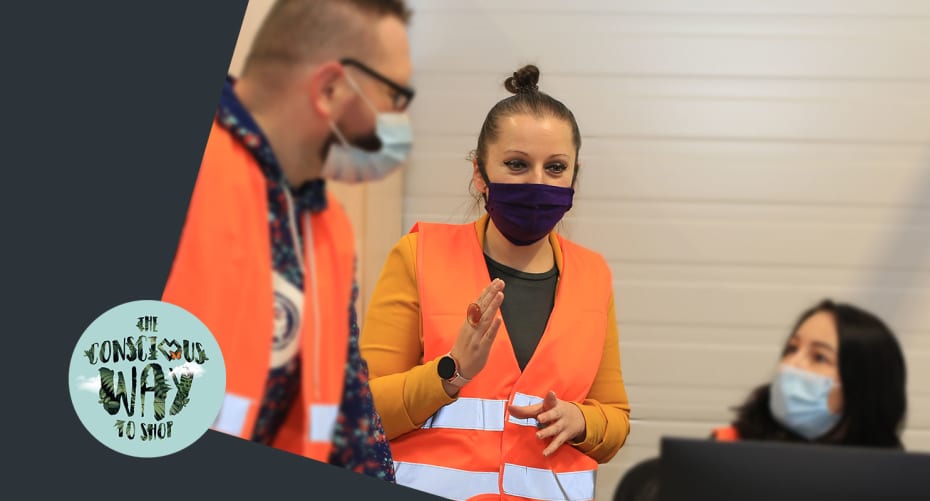60 new items of clothing are bought per person per year in Germany alone. In total, that’s 5.2 billion garments, 2 billion of which Greenpeace estimates are rarely or never worn. In the fight against overproduction in the fast-fashion industry, print on demand (POD) has a decisive advantage: items are only produced when and how the customer wants them. Could this provide leverage to make the textile industry more sustainable? Ewa Ziemba, manager of our Polish Spread Group plant in Legnica, summarizes the advantages Print-on-Demand (PoD) has over conventional textile production.
Ewa has been with Spread Group since 2007. She started her career as working in production and today successfully manages our plant in Legnica. Its 232 employees ensure that millions of T-shirts, sweaters and accessories reach our customers in impeccable condition. Last year alone, around 2.7 million items were printed and shipped to more than 180 countries. As plant manager, Ewa is concerned with the carbon footprint of the products finished at her site: “With our organic collection, the carbon footprint is more than 20 percent smaller than a typical white T-shirt bought from a retail shop. A standard T-shirt has a footprint of 3.7 kilograms of carbon dioxide during its “life cycle.””
1. Resource-saving production
In the print-on-demand business model, customers often become designers: they design their own garments, put a lot of heart and soul into them, and wear these unique items on special occasions, such as weddings or bachelor parties. This kind of self-designed clothing has a longer life cycle than standard T-shirts. This is a major advantage for brands like Spread Group, who are aiming for more sustainable textile production: There are few returns and no offcuts are made in the warehouse. “We regularly donate our like-new returned items to charity. We have products featuring personal designs or company logos processed directly into insulation- so we make sure that no resources are wasted,” explains Ewa Ziemba.
2. Water-saving Digital Direct printing process
The Digital Direct process is a method that is widely used throughout the industry and is more eco-friendly than other standard methods. Unlike other printing processes, such as screen printing, it requires considerably less water to apply designs precisely onto garments. Most garments for the Spread Group brands are finished using this method at the Legnica site, explains Ewa Ziemba: “We work with Kornit and Brother in the Digital Direct printing process because their machines produce high print quality and their ink is water-saving and sustainable. As a vegan ink, it even has the “OEKO-TEX Eco Passport” certification.”
3. Fair production conditions
In the established POD industry, fair working and production conditions are contractual by default in the company’s Code of Conducts. Many companies, such as the Spread Group brands, also maintain a long-standing partnership with their producers: “Our colleagues from the Supply Chain Management and Purchasing departments have met many of our partner entrepreneurs personally on several occasions. They were able to see the high social standards on-site for themselves, without which we would not enter into a business cooperation,” confirms Ewa Ziemba.
4. Transparent supply chains
As in any manufacturing industry, POD companies also account for a high proportion of CO2 emissions in their supply chains – from raw material extraction to direct suppliers. For Spread Group’s own collection, the organic cotton is grown in Turkey, processed locally to t-shirts and hoodies, and sent to European production sites, such as the factory in Legnica, for finishing. However, Spread Group’s range also includes sustainable alternatives, such as products from Stanley & Stella, Neutral and Continental Clothing. Sustainability is also taken into account in the transport routes, explains Ewa Ziemba: “We have technologically optimized the processes so that, among other things, the orders are automatically printed at the production site that has the shortest distance to the end customer. As a result, our organic collection currently has the lowest carbon footprint within our entire product portfolio.”
5. Lower return rates
The print-on-demand production process has been proven to reduce return rates: the individually-designed items are made to order and thus mostly meet customer expectations. Last year, for example, the return rates for Spread Group brands in Germany was around 5%, well below the national average of 12% for online retailers, as Ewa Ziemba can confirm: “I also put the low return rates down to our high print and design quality. For example, we’ve worked on rejecting designs with too low a pixel quality below 1000px so that we always achieve first-class print results.”
Related link:
More on sustainability at Spread Group: www.spreadgroup.com/sustainability
GET IN TOUCH

